The Nigerian Dwarf Milking Machine: An In-Depth Guide
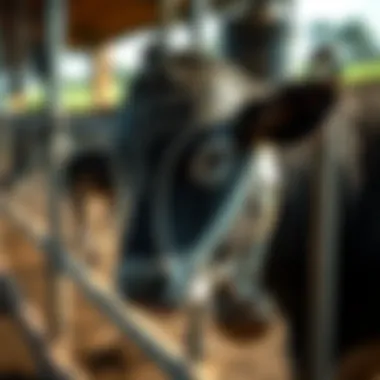
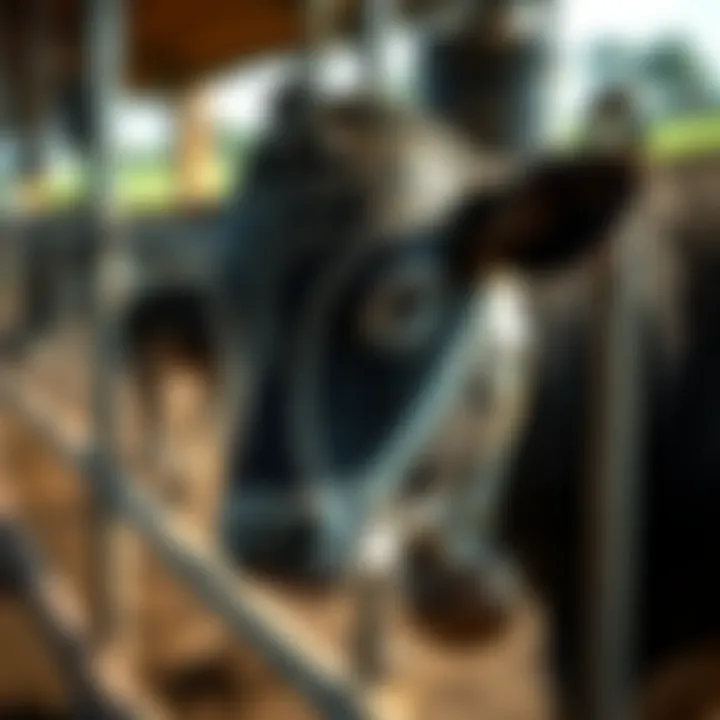
Intro
In the realm of dairy farming, the choice of equipment can make all the difference between a thriving operation and a struggle for productivity. For those engaged with Nigerian Dwarf goats, which are known for their high-quality milk and manageable size, the milking machine tailored for their needs represents a critical innovation. As their popularity rises among hobbyists and small-scale farmers alike, understanding how this equipment works and its benefits becomes increasingly important.
This article seeks to unravel the nuances of the Nigerian Dwarf milking machine, diving into its design, functionality, and the tangible advantages it offers to users. Whether you are a seasoned farmer looking to improve your current practices or a newcomer eager to enter the world of dairy, this comprehensive guide will provide insights that can enhance not only productivity but also animal welfare.
Furthermore, we'll touch on maintenance tips, troubleshooting advice, and how practical adaptations can facilitate smoother operations. The knowledge shared in this piece aims to equip stakeholders in the agriculture sector with information they can use to optimize their dairy farming efforts.
Key Concepts and Terminology
Basic Definitions
Understanding the key concepts surrounding milking technology is essential. The Nigerian Dwarf milking machine is specifically designed for the unique anatomy and milking needs of Nigerian Dwarf goats. These machines typically feature:
- Pulsation process: Allows for gentle stimulation of the udder, ensuring that milking is both efficient and stress-free for the goat.
- Adjustable settings: Tailoring the machine to the goat's size and milking rhythm enhances comfort.
- Compact design: Ideal for smaller farms or spaces, reflecting the typical environment where Nigerian Dwarf goats are housed.
Historical Context
The use of milking machines can be traced back to the late 19th century when demand for dairy products surged. However, it wasn't until the introduction of modern technologies that machines began integrating effectively into smaller farms. The Nigerian Dwarf breed emerged as a popular choice among dairy farmers due to its adaptability and vibrant personality, leading to a more tailored development of milking machines suitable for their specific needs.
As dairy farming evolved, the significance of maintaining efficiency while prioritizing animal welfare became paramount. Thus, the development of specialized equipment, including the Nigerian Dwarf milking machine, marked a notable shift towards enhancing productivity without sacrificing the wellbeing of the animals.
Recent Innovations and Trends
Technological Advancements
In a constant quest for efficiency, the milking industry has seen several innovations aimed at both improving performance and securing animal health. Some noteworthy advancements include:
- Smart technology integration: With the advent of IoT (Internet of Things), some modern milking machines now allow farmers to monitor the milking process and goat health remotely. This ensures that any potential issues can be addressed promptly.
- Sustainable materials: There's a growing trend towards using biodegradable and recyclable components in the production of milking machines, aligning with global sustainability goals.
Sustainable Practices
Sustainability in farming isn't just a buzzword; it's a necessary approach for the future of agriculture. The Nigerian Dwarf milking machine contributes to this ethos through practices designed to:
- Reduce energy consumption by optimizing the milking process.
- Minimize waste produced during operation, with many systems designed for easy cleaning and maintenance, resulting in less resource usage over time.
Practical Applications and Techniques
Step-by-step Guides
For those new to using a Nigerian Dwarf milking machine, mastering the setup and operation is crucial. Below is a basic guide to get you started:
- Preparation: Ensure you have all necessary equipment, including the milking machine, cleaning supplies, and comfort items for the goats.
- Cleanliness: Before starting, wash your hands and clean the milking machine thoroughly to prevent any contaminants from affecting the milk.
- Introduce the machine: Calmly introduce the goat to the machine, allowing them time to adjust without feeling frightened.
- Milking: Operate the machine according to the manufacturer’s instructions, monitoring the goat's comfort throughout the process.
- Post-milking care: Clean the equipment again to maintain hygiene, and reward the goat with a treat for a job well done.
Case Studies
To illustrate the practical applications of the Nigerian Dwarf milking machine, consider the case of a small-scale farm in Texas, where a couple transitioned to using this specialized equipment.
- Initially dependent on hand milking, they faced physical strain and inefficiencies.
- After investing in a Nigerian Dwarf milking machine, they reported:
- A 50% reduction in milking time.
- An increase in milk production per goat, attributed to reduced stress during the milking process.
- Enhanced overall goat health and demeanor, as milking became less of a hassle.
"Our transition to the milking machine has been a game changer. Not only have we saved time, but our goats seem much happier too!"
– Texas Farm Owner
Understanding these aspects will provide stakeholders with comprehensive insights into maximizing the use of the Nigerian Dwarf milking machine in their operations, supporting both productivity and welfare standards.
Preamble to Nigerian Dwarf Goats
Nigerian Dwarf goats, despite their small stature, are increasingly becoming important players in the dairy goat sector. Understanding these goats is fundamental to grasp how milking machines designed specifically for them can optimize farming practices. Nigerian Dwarf goats are not just another breed; they bring a unique set of traits and advantages that make them ideal for small-scale dairy farming. With their manageable size and friendly temperament, they are also suitable for novice farmers looking to enter the dairy marketplace.
Traits and Characteristics
Nigerian Dwarf goats are recognized for their pint-sized figures, typically standing between 17 to 21 inches tall. This diminutive size doesn't compromise their productive capacity; in fact, they can produce milk with a butterfat content between 6% to 10%. Their coat can be a range of colors and patterns, making them visually appealing as well. What sets them apart is not only their physical traits but also their lively personalities. These goats are known to be quite sociable and are often seen interacting positively with both humans and other livestock.
Their compact build allows them to thrive in smaller spaces, which is a boon for farmers with limited land. This characteristic makes them ideal for urban settings or places where space is at a premium. Additionally, these goats are hardy and adapt well to various environments, whether it's a hot climate or a cooler region. These features combined not only enhance their appeal but also their viability in mixed farming systems where various livestock cohabit.
Popularity in Dairy Farming
The rise in popularity of Nigerian Dwarf goats in the dairy farming sector can be attributed to several factors. First, their efficient milk production makes them a favorite among small-scale and hobby farmers. Unlike larger breeds that require extensive resources and management, Nigerian Dwarfs offer a more feasible alternative for those looking to produce quality milk without significant investment.
Moreover, the milk produced by these goats is highly sought after in artisan cheese production, given its rich flavor profile and high fat content. The economic aspect is compelling too; as consumers become more interested in local and sustainable dairy products, Nigerian Dwarf goats provide an excellent option.
Additionally, the breed's sociability means they're often a joy to work with, which adds to the overall satisfaction of keeping livestock. Farmers around the globe are also realizing that Nigerian Dwarf goats can produce substantial quantities of milk on a smaller scale, leading to a growing community of enthusiasts who share their experiences and best practices online.
In summary, these goats represent much more than just livestock. They symbolize a shift towards more sustainable, efficient, and enjoyable farming methods that cater to the contemporary agricultural landscape.
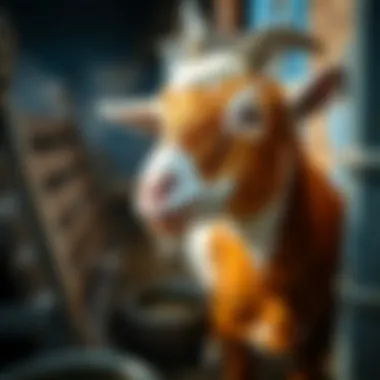
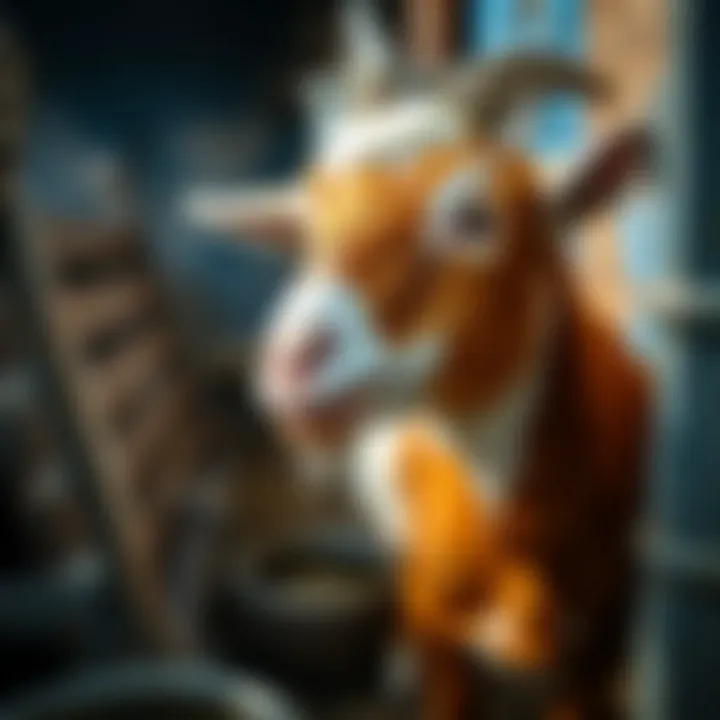
Understanding Milking Machines
The role of milking machines in modern dairy farming cannot be overstated. For farmers, particularly those focusing on the Nigerian Dwarf breed, grasping the nuts and bolts of these machines will ensure effective milking practices and higher productivity. As the farming landscape continues to evolve, understanding milking machines helps streamline operations and improve overall animal welfare.
Milking machines can significantly enhance the efficiency of your milk production. They automate the process that otherwise would take hours and require manual effort. This translates to time saved that can be allocated to other essential tasks, such as feeding and caring for the goats. Furthermore, a well-designed milking machine tailored for Nigerian Dwarfs respects their unique physiology, making the experience less stressful for the animals and ultimately leading to better milk quality.
Types of Milking Machines
Milking machines come in various shapes and sizes, designed to accommodate different needs in the dairy operation. Some common types include:
- Rotary milking machines: Often used in larger dairy operations for multiple animals. They allow for continuous milking.
- Portable milking machines: Ideal for small-scale farms or home use, as they offer convenience and easy mobility.
- Bucket milking systems: Traditionally used in smaller setups, where milk is collected in a bucket immediately after suction.
Each type has its strengths and weaknesses. For example, while rotary systems can handle a larger volume, they may not be essential for smaller farms focusing on Nigerian Dwarfs, where a portable option could be more practical.
Key Components Explained
Vacuum systems
Vacuum systems are the backbone of any milking machine. These systems create a suction that draws milk from the udder into the storage containers. A significant aspect of vacuum systems is their adjustable pressure, which is crucial in maintaining comfort for the goats. Too low of a pressure may prevent effective milking, while too high could potentially harm the animals.
A standout feature of vacuum systems is their ability to provide consistent suction, which is vital in ensuring a steady flow of milk. This uniformity leads to quicker milking times and less stress on the goats. However, regular maintenance is paramount as dirt and moisture can lead to inefficiencies or even malfunctions.
Milking clusters
Milking clusters, often referred to as clusters or teat cups, attach to the goats' udders and are a key point in the milking process. Their design usually includes silicone liners that are gentle on the skin, making them a popular choice for milkers who prioritize animal comfort. What's beneficial about milking clusters is that they can vary in number, accommodating the specific needs of your Nigerian Dwarf goats.
A unique aspect of milking clusters is their ability to remain securely in place while alternating between suction and release, mimicking the natural suckling of kids. While this feature increases efficiency, one must ensure that the cluster fits appropriately to avoid damages and discomfort.
Milk storage containers
Milk storage containers play an essential role post-milking, ensuring that the milk remains fresh and safe for consumption. These containers are usually made from food-grade stainless steel, which prevents bacterial growth while maintaining the quality of the milk. A prominent characteristic of these containers is their insulation properties, keeping the milk cool and preserving its freshness for longer periods.
The unique feature of these containers is their capacity to hold varying quantities of milk, which can cater to different farming operations from small to larger dairy productions. While they offer numerous advantages like durability and easy cleaning, farmers must also consider their size and handling, as larger containers require more space and effort to transport.
The Design of Nigerian Dwarf Milking Machines
The design of Nigerian Dwarf milking machines is a crucial aspect that affects not only the efficiency of milking but also the well-being of the goats being milked. These machines cater specifically to the unique anatomy and size of Nigerian Dwarf goats, setting them apart from standard milking equipment often designed for larger breeds. Understanding the design specifics allows farmers to optimize milking processes and, by extension, their dairy production.
Size and Ergonomics
When it comes to the size and ergonomics of milking machines for Nigerian Dwarf goats, it’s essential to dive into how the dimensions of the machine are tailored to suit the smaller stature of these animals. A milking machine that is too large or cumbersome can create stress for the goat, leading to discomfort during milking. Therefore, a design that considers the height of the animals, along with their shorter teats, ensures a smoother, more effective milking process.
For instance, a machine designed specifically for Nigerian Dwarfs will possess:
- Lower height: This makes it easier to position the goat comfortably, reducing the risk of injury to both the animal and handler.
- Adjustable attachments: These can be modified to fit the various sizes of teats found in different Nigerian Dwarfs, accommodating individual animal characteristics.
- Lightweight structure: Farmers often need to move milking machines around. A lightweight design reduces the physical strain on users.
In essence, incorporating ergonomic principles leads to less resistance during milking, which is a blessing both for the goats who can be more relaxed and for farmers who can work more efficiently.
Material Considerations
The materials used in constructing Nigerian Dwarf milking machines are just as critical as their size. Selecting the right materials can impact the longevity, cleanliness, and functionality of the machines.
For optimal performance, the following materials are commonly considered:
- Stainless Steel: This material is paramount for components that come into direct contact with milk. Stainless steel is easy to clean, resistant to corrosion, and does not retain odors, making it the ideal choice for milk storage tanks and pipelines.
- Food-grade plastics: These are often utilized in flexible parts of the machine or in areas where lightweight components are needed. Plastics used must be rated for food safety to ensure they do not leach harmful substances during operation.
- Durable rubber: Used in the milking cups, the rubber must be soft enough to create a seal but robust enough to withstand repeated use. Having a soft touch allows the cups to conform to the goat’s body without causing irritation.
Ultimately, the right material choices lead to a milking machine that not only works efficiently but also lasts longer and requires less maintenance.
"The design considerations of size and material in milking machines can fundamentally change the experience of both farmers and their goats."
By marrying ergonomic designs with durable materials, manufacturers can create milking machines that align closely with the needs of Nigerian Dwarf goats. This attention to design is what fosters an effective dairy farming operation.
Functionality and Efficiency
When delving into the realm of dairy farming, particularly with Nigerian Dwarf goats, functionality and efficiency of milking machines emerges as a pivotal focus. An effective milking machine does not only streamline the milking process; it fundamentally enhances the overall productivity of the farm. The intricate design and operation of a milking machine cater specifically to the needs of these smaller-sized animals, facilitating an ergonomic and user-friendly approach.
One significant element in this discussion is the operational mechanism of the milking machine. This encompasses how the machine functions to collect milk while ensuring the comfort of the goat. Typically, most milking machines operate using a vacuum system that effectively extracts milk without causing distress to the animal. The milking clusters are designed to adhere securely to the teats, allowing for a consistent flow that mirrors natural milking. Efficiency hinges on this mechanism, as a well-designed system minimizes the time spent on each goat without compromising milk quality.
Another aspect worth considering is the ease of setup and operation. Users often find that familiarizing themselves with the operational bottlenecks can lead to smarter decisions regarding interventions and maintenance practices. This prevents lapses in productivity and surprises during peak milking hours. Thus, it becomes crucial for farmers to understand the nuances of their machines and to establish a routine that keeps everything running smoothly.
Operational Mechanism
The operational mechanism primarily hinges on the interaction between vacuum pressure and the physical components of the machine. The vacuum system creates a negative pressure that facilitates milk extraction while minimizing the risk of injury to the goats. An efficient system often includes a pulsator that regulates the cycles of vacuum, allowing for a gentle pulsating action that closely resembles the natural sucking of a kid.
Factors such as the diameter of the tubing, the design of the milking cluster, and overall suction power greatly affect its efficiency. A system that’s too powerful can create discomfort, leading to stress for the goats and ultimately, a lower yield. In contrast, inadequate suction may prolong the milking time and reduce total milk output. This balance is essential, and farmers must adjust settings according to the unique characteristics of their Nigerian Dwarf goats.
Impact on Milk Yield
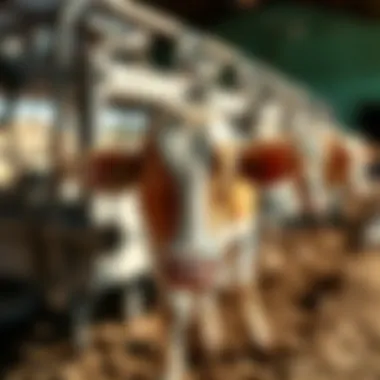
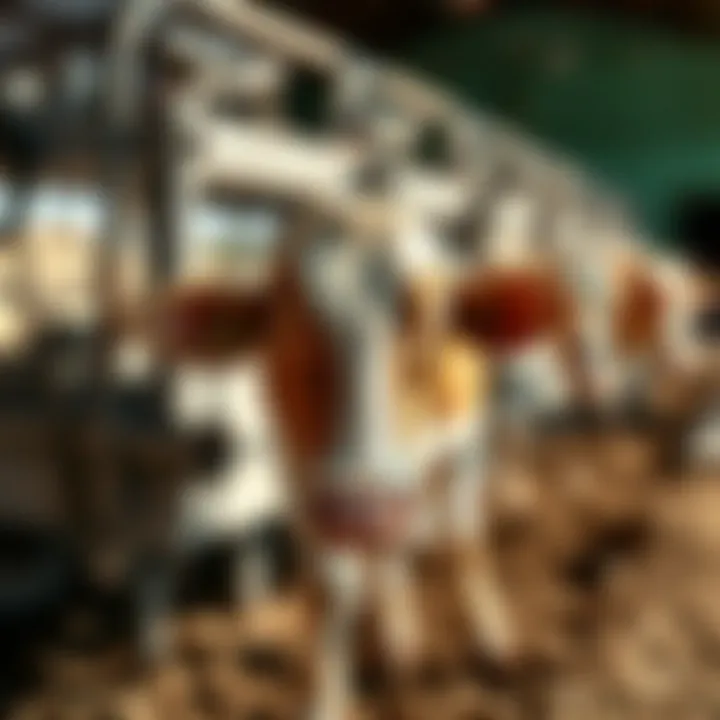
The functionality and efficiency of the milking machine directly correlate with milk yield, which is often the bottom line for dairy farmers. Properly operated milking machines tend to yield a higher quantity of milk while also maintaining quality. Milking should happen consistently and at optimal times to ensure that production remains stable and predictable.
"Effective milking practices will lead to sustainable dairy production, especially in niche markets like that of Nigerian Dwarfs."
Additionally, technology such as milk meters can provide real-time data on milk yield, guiding farmers in making informed decisions about herd management practices. Understanding the impact of milking frequency and timing will also influence overall production. Ultimately, an efficient system not only saves time but fosters a productive environment for both farmers and their livestock.
Investing in a high-quality milking machine that is tailored for Nigerian Dwarf goats can result in significant improvements in yield, thus justifying the initial investment in technology. With careful attention to the functionality of milking equipment, farmers can significantly enhance their operations, keep their goats healthy, and maintain productive milking routines.
Benefits of Using Milking Machines
Milking machines have become an invaluable asset for dairy farmers, especially those working with Nigerian Dwarf goats. These compact, hearty animals are known for their high milk production relative to their size, making efficient milking processes vital. Using milking machines brings significant advantages that resonate not only with productivity but also with animal health and welfare.
Time Efficiency
One of the foremost benefits of utilizing a milking machine is time efficiency. Traditional milking methods can be labor-intensive, requiring significant manual effort and time. In contrast, milking machines can substantially speed up the milking process.
For instance, instead of spending up to an hour milking by hand, a farmer can often complete the same task in less than half that time with a machine. This is particularly advantageous during peak milking seasons where time is of the essence.
- Reduction of Labor Cost: With a milking machine, a single user can milk several goats simultaneously, meaning fewer hands are needed. This can significantly cut labor costs, allowing funds to be redirected to other operational needs.
- Scalability: As the farm grows, milking machines allow for easier scaling of production. With the ability to milk more goats in less time, farmers can expand their herds without the same increase in labor.
- Consistency in Milking Times: Regular milking intervals are critical for maintaining milk production. A machine ensures that milking happens consistently, avoiding complications that can arise from irregular schedules.
Animal Welfare Considerations
The welfare of Nigerian Dwarf goats is paramount, and milking machines address this concern profoundly. An efficient milking machine can help maintain a stress-free environment for the goats, leading to better milk yield and overall well-being.
Using a milking machine allows for a gentle approach, which minimizes discomfort and potential injuries that can arise from manual milking. Consider the following aspects:
- Gentle Milking Process: Most modern milking machines are designed to imitate the natural sucking action of a goat's kid. This helps reduce stress and anxiety in the animals, fostering a calm environment.
- Reduction of Human Contact: With less frequent direct human handling during the milking process, goats can feel more secure, allowing them to be more productive and healthier.
- Hygiene Improvements: Milking machines often come with features that promote better sanitation. Cleanliness is crucial in dairy farming to prevent infections and diseases that could be harmful to goats. By automating the process, it minimizes human error regarding hygiene standards.
"Efficient milking not only boosts productivity but significantly supports the health and happiness of dairy goats."
In summary, the use of milking machines for Nigerian Dwarf goats represents a critical advancement in dairy farming. By enhancing efficiency and promoting animal welfare, these machines align perfectly with the needs of modern agricultural practices. As farmers continue to seek ways to optimize their operations, the advantages offered by milking machines cannot be overlooked.
Potential Challenges and Solutions
As engaging with technology becomes increasingly vital in dairy farming, recognizing hurdles that might arise when operating a Nigerian Dwarf milking machine is crucial. Addressing potential challenges ensures smoother operation and better productivity. By understanding these common issues, farmers can prepare effectively and implement practical solutions, leading to a more efficient milking process and enhanced animal welfare.
Common Issues in Milking Processes
Milking machines can be a game-changer; however, they are not without their quirks. A few typical gremlins that farmers might encounter include:
- Inconsistent Milk Flow: This can stem from improper settings or a malfunctioning vacuum system, making it essential to regularly check these components.
- Over-Milking: It’s easy to think that more is better, but over-milking can lead to injury for the goats. Monitoring milk output is key to preventing this from happening.
- Teat Injury: If the machine is not calibrated well or used improperly, it might cause harm to the animals. Regular inspection of milking clusters is crucial to ensure they’re not too tight or misaligned.
- Dirty Equipment: Milking machines must be kept clean. Neglecting this can lead to infections in the goats or spoilage of milk, impacting both health and profits.
By staying alert to these common issues, farmers can keep their operations running like well-oiled machines.
Maintenance Tips
A stitch in time saves nine, especially when dealing with milking machines. Proper upkeep extends the life of equipment and ensures it operates efficiently. Here are several maintenance tips:
- Regular Cleaning: After each use, make it a point to clean all components. Dirty equipment can lead to bacterial growth, affecting milk quality.
- Routine Inspections: Regularly inspect vacuum systems, pulsators, and milking clusters for wear and tear. An ounce of prevention will go a long way.
- Calibration Checks: Regularly calibrate the machine to ensure that it operates at optimal settings. A poorly calibrated machine can lead to inefficiencies.
- Use Quality Materials: When replacing parts, always opt for original or high-quality replacements. Cheap components can lead to more problems down the road.
By integrating these maintenance habits, farmers will find they have fewer substantial issues to contend with.
Troubleshooting Guide
Even with all precautions, hiccups are bound to occur. It's all part of the learning curve. Here are handy troubleshooting tips for some common scenarios:
- Inconsistent Milk Flow: If there’s an issue, start by checking the vacuum levels. Use a manometer to ensure it’s within the normal range. If needed, adjust the vacuum controls or inspect for blockages in the hoses.
- Teat Injury: If injuries are observed, first ensure the milking cluster is fitted correctly. Check for over-tightening. If injuries continue, it might be worth consulting with a veterinarian and reassessing the milking technique used.
- Excessive Noise or No Functionality: If the machine makes strange noises or stops working entirely, cut the power and inspect mechanical components for wear and tear. Sometimes, just reseating parts can rectify issues.
As problems are resolved, it becomes easier to harness milking technologies effectively and ensure a productive dairy operation.
Implementing a proactive approach to manage potential challenges can significantly improve the overall efficiency of the milking process and safeguard your herd's wellbeing.
Adaptations for Home Use
The adaptations for home use of the Nigerian Dwarf milking machine emphasize the growing need for small-scale dairy farming solutions that cater to enthusiasts and hobbyists. More people are turning to homesteading and backyard farming, so having equipment specifically designed for home use is vital. Many find themselves in a unique position where they want fresh, high-quality milk without the burden associated with larger commercial setups. These adaptations not only make milking more accessible but also enhance the overall experience of managing a small dairy herd.
Portable Models
When it comes to milking Nigerian Dwarf goats at home, portability is a significant factor. Home farmers may not have the luxury of a permanent dairy facility, and a machine that can be easily transported makes life simpler.
- Lightweight Design: Many portable models are designed to be light and easy to maneuver. This means you can set them up in your barn, your backyard, or anywhere you can gather your goats without a herculean effort.
- Battery-Operated Options: Some machines operate on batteries, allowing for hassle-free transport and use where electrical outlets might not be available.
- Compact Size: These models often have a smaller footprint, allowing for storage in tight spaces, like sheds or garages.
"The right portable milking machine can transform your milking routine from a chore into a quick, seamless experience."
Household dairy farmers can take advantage of these features to streamline the milking process, making it feel less like work and more like a satisfying part of the daily routine.
Cost-effective Solutions
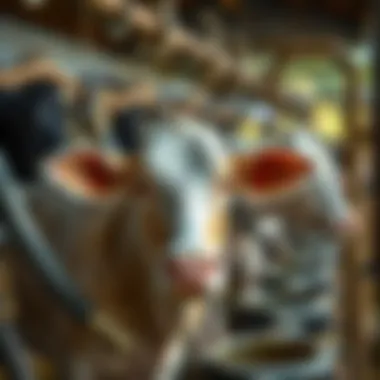
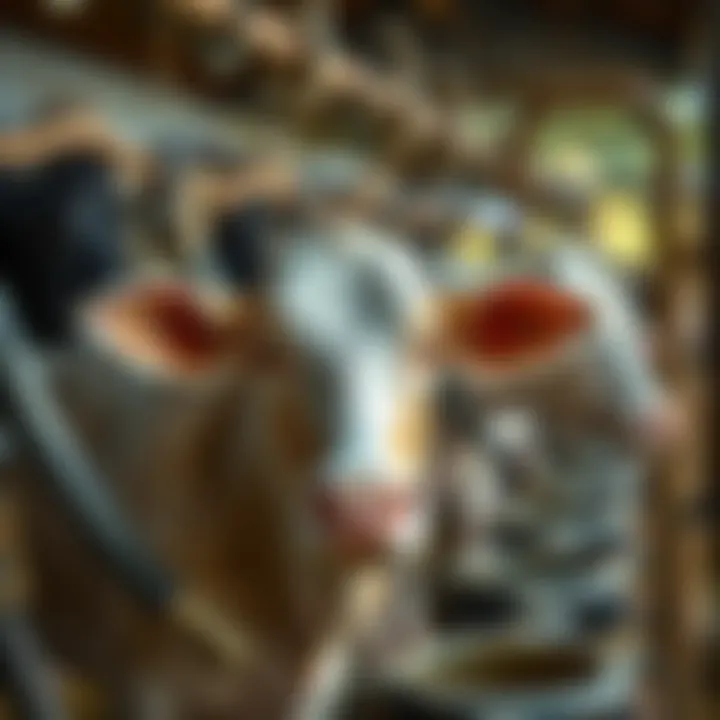
Cost is another pressing matter when it comes to home use of milking machines. Many aspiring dairy farmers often grapple with budget constraints. Luckily, there are cost-effective solutions that don’t compromise quality.
- Basic Models: Opting for simpler machines with fewer bells and whistles can be a wise move. Basic models typically have lower initial costs without sacrificing milking efficiency.
- Used Equipment: Many farmers find success by purchasing second-hand equipment. Platforms such as reablished forums on Reddit or local farming groups on Facebook enable users to buy reliable pre-owned machines at a fraction of the original price.
- DIY Options: Some skilled farmers decide to create their own milking systems. Utilizing widely available components, they can custom-make machines tailored to their specific needs, saving money while gaining a practically tailored solution.
User Experiences and Testimonials
User experiences and testimonials serve as a window into the practical realities of using Nigerian Dwarf milking machines. They shed light on the performance and usability of the equipment, helping potential users understand what to expect before making a purchase. For many farmers, firsthand accounts can provide a wealth of knowledge that technical manuals often lack. After all, when it comes to dairy farming, nothing beats learning from those who have stood in the trenches, milking their goats under the sun.
Real-world Applications
The application of these milking machines in real-life scenarios varies greatly, reflecting the myriad of farming setups they are integrated into. Here are a few noteworthy applications:
- Small-scale Farms: Many users report that the Nigerian Dwarf milking machine excels in small-scale operations. Its compact size is a boon for farmers with limited space. They often find that they can efficiently milk more than one goat at a time without sacrificing quality.
- Backyard Dairy Enthusiasts: Home dairymen and women have also embraced these machines. For them, the desire is not just about quantity but quality too. User reviews highlight how the machines maintain milk purity and freshness, which is invaluable for artisanal cheese making.
- Commercial Operations: Even in slightly larger commercial scenarios, these machines find a place. Farmers have shared that they appreciate the low maintenance coupled with high output. The efficiency of these machines leads to significant time savings, helping them focus on other essential tasks on the farm.
In the words of one user: > "I was wary at first, but once I started using the milking machine, it felt like a breath of fresh air. I could milk four goats in the time it used to take me to do one by hand!"
Each of these examples underscores the adaptability of Nigerian Dwarf milking machines, allowing users to tailor their milking routines to specific needs and situations.
Challenges Faced by Users
As with any equipment, the road isn't always smooth. Users have encountered challenges that highlight the learning curve associated with the transition to mechanized milking. A few common hiccups include:
- Initial Setup Issues: Many users have reported confusion during the initial setup. It's often not as plug-and-play as one might think. Some components may require fine-tuning or calibration before achieving optimal performance, which can be frustrating for first-time users.
- Routine Maintenance: Keeping the machinery in top condition is vital, leading to challenges in learning how to properly clean and maintain the unit. Neglecting this can hinder performance and lead to more significant issues down the line.
- Understanding Goat Responses: Some farmers might find that their Nigerian Dwarf goats can be a bit skittish around new technology. User testimonials reveal that patience and gentle handling are key to helping the goats acclimatize to the milking machine.
In a shared moment, a farmer explained the importance of being gentle: "At first, my goats were nervous. But with time and treats, they fell right in line. Now they practically line up for their turn!"
In summary, while challenges exist, the love for these machines often shines through. Users have found that overcoming these hurdles adds a layer of satisfaction to their milking process, leading to greater reliability and overall productivity.
Comparative Analysis
In this section, we will delve into the comparative analysis of the Nigerian Dwarf milking machine, an important consideration as it sheds light on the strengths and weaknesses of these machines in relation to milking devices created for other goat breeds. This analysis not only helps determine the suitability of a machine for specific farming needs but also assists farmers in making informed decisions regarding the best equipment for their operations.
Nigerian Dwarf vs. Other Goat Breeds
The Nigerian Dwarf goat, known for its smaller size and high butterfat milk production, stands out among its peers. When it comes to milking technology, several factors come into play when comparing the Nigerian Dwarf to other breeds like Saanen, Nubian, or Alpine goats.
- Size Considerations: Milking machines designed for larger breeds may not be suitable for Nigerian Dwarfs due to their smaller stature. With equipment that's too large, there's a risk of injury or discomfort for the goats. Therefore, machines need to be tailored in size to enhance both efficiency and animal welfare.
- Milk Composition: The Nigerian Dwarf breed produces milk with a higher fat content compared to some other breeds. This characteristic may require different milking techniques or machine settings to optimize milk extraction. Users could see experiments with vacuum pressures or milking speed to accommodate this unique aspect.
- Adaptability: Not all milking machines can accommodate the milking habits of various goat breeds. The Nigerian Dwarf’s behavior, especially during milking, may necessitate features like quieter motors to keep the goats calm or adjustable settings to suit their temperament.
By understanding these dynamics, milking equipment developers can produce more specialized tools that benefit both farmers and animals alike.
Market Availability of Machines
When considering the Nigerian Dwarf milking machines, it's essential to look at the market availability of such specialized equipment accompanied by their costs and accessibility.
- Diversity of Choices: The market for milking machines is vast, yet only a limited selection caters specifically to the Nigerian Dwarf breed. As awareness of this breed's popularity in dairy farming grows, manufacturers may be encouraged to expand their product lines to include tailored machines for these goats.
- Cost Factors: The price of a milking machine can vary widely. Typically, machines that are specially designed for Nigerian Dwarfs may fall into different price brackets compared to those intended for larger dairy goats. Farmers must consider their budget while also weighing the long-term benefits of investing in equipment that meets their needs effectively.
- Availability from Suppliers: Many agricultural supply stores may not stock machines specifically designed for the Nigerian Dwarf goat, prompting farmers to look online for specialized retailers. It’s prudent to research suppliers on platforms like Farm and Dairy or on community forums such as Reddit to find recommendations based on user experiences.
In summary, the comparative analysis of the Nigerian Dwarf milking machine against others provides significant insights into optimization across various aspects of dairy farming. The information collected from this sector opens up avenues for discussions on cost, functionality, and vital adjustments, ensuring that both stakeholders in agriculture and dairy enthusiasts can explore what best suits their needs.
Future Trends in Milking Technology
The landscape of milking technology is evolving at a rapid pace, and understanding these trends is key for modern dairy farmers who want to optimize their operations. Innovations are not just about improving efficiency but also enhancing animal welfare, quality of milk, and sustainability in farming practices. For those involved with Nigerian Dwarf goats, these trends hold special significance, as this breed has unique needs that can be better served with the right technological advancements. The push towards automation and smarter machine design is changing the way milking is approached.
Innovations on the Horizon
In the domain of milking technology, the spotlight is increasingly focused on intelligent systems that can adapt to specific herds. One promising development is the advent of smart milking machines equipped with sensors that monitor the health and well-being of goats during the milking process. These machines can detect abnormalities through data analysis, potentially flagging issues like mastitis before they become serious concerns. Additionally, there is momentum towards robotic systems which promise unparalleled consistency and efficiency. Here’s what to keep an eye out for:
- Automated Milking Systems (AMS): These allow goats to be milked on their own schedule, reducing stress and optimizing yield.
- Mobile Applications: Farmers can now monitor their milking operations in real-time via smartphone, providing alerts and reports from anywhere.
- Advanced Cleaning Technologies: Inline cleaners equipped with bio-sensors to ensure the hygiene of equipment, crucial for quality milk production.
"The future of milking machines doesn’t just revolve around machines; it’s about integrating technology that enhances the entire farming experience."
As these innovations come into play, they promise not only to streamline processes but also to lift the overall standard of dairy farming, particularly for breeds like Nigerian Dwarfs that may require thoughtful care.
Sustainability Considerations
As the focus on sustainability grows, the agricultural sector is pushed to adapt practices that minimize environmental impacts. Milking technology is at the forefront of this movement, especially with sustainable solutions that directly affect dairy operations. Here are several sustainability trends likely to shape the future of milking practices:
- Energy Efficiency: Modern milking machines are designed to consume less power without sacrificing performance. Innovations in battery technology and energy-efficient motors are becoming standard.
- Recyclability of Material: The use of recyclable materials in the construction of milking machines is rising. This approach not only helps reduce waste but also aligns with global sustainability goals.
- Water Conservation: New systems utilize recycled water for cleaning and operations, which is essential in areas facing water scarcity.
Farmers embracing these practices do not only contribute to environmental health but can often find financial benefits through reduced operational costs and better product quality.
Epilogue
In this comprehensive exploration of milking machines specifically designed for Nigerian Dwarf goats, we've seen how key elements like functionality and design play pivotal roles in enhancing dairy farming practices. Understanding these machines not only informs better buying decisions but also fosters improved animal welfare and operational efficiency. The pursuit of effective milking methods transcends mere convenience; it symbolizes a commitment to nurturing livestock and maximizing productivity.
Key Takeaways
- Understanding Machine Design: Milking machines for Nigerian Dwarfs must be compact yet efficient, considering the goats' size without compromising comfort.
- Operational Benefits: Employing good milking machinery can significantly reduce the time spent on chores while increasing milk yield.
- Animal Welfare: Proper usage of these machines ensures less stress for the animals compared to conventional hand-milking methods.
- Maintenance is Crucial: Routine checks are necessary to prevent breakdowns and ensure the longevity of the equipment.
A well-maintained milking machine can save time and resources, thereby enhancing the overall productivity of a dairy farm.
Final Thoughts on Milking Methods
The knack for optimizing milking practices rests as much on the equipment as it does on the operators' knowledge of their chosen methods. Farmers should prioritize understanding the specific needs of their livestock alongside the capabilities of the machines they're using. As technology continues to evolve, staying informed about newer innovations will likely yield advantages in both production and animal care. Embrace change, yet always uphold the dedication to quality and compassion in your farming methods. By doing so, you align profitability with a sustainable approach to dairy farming.















